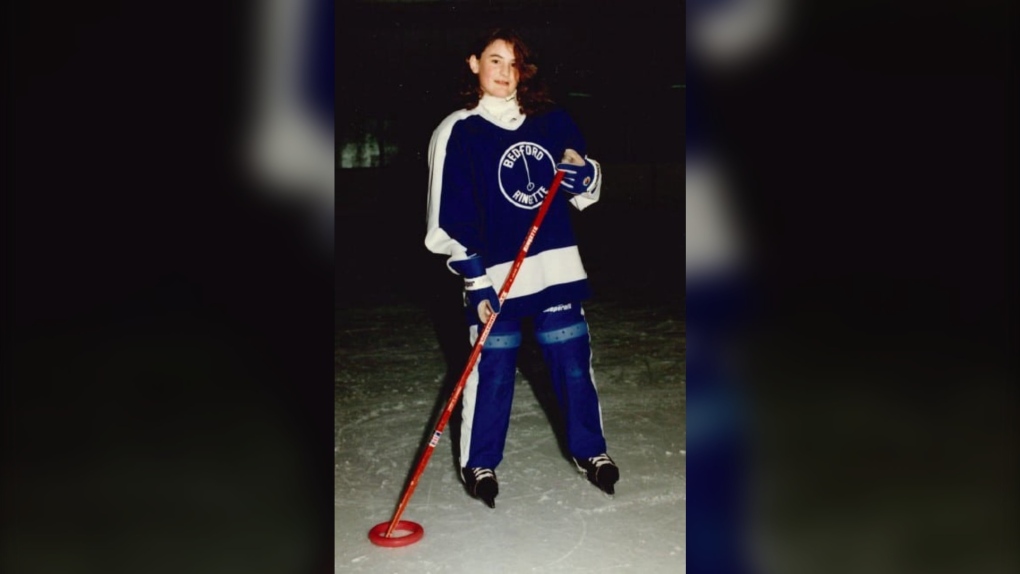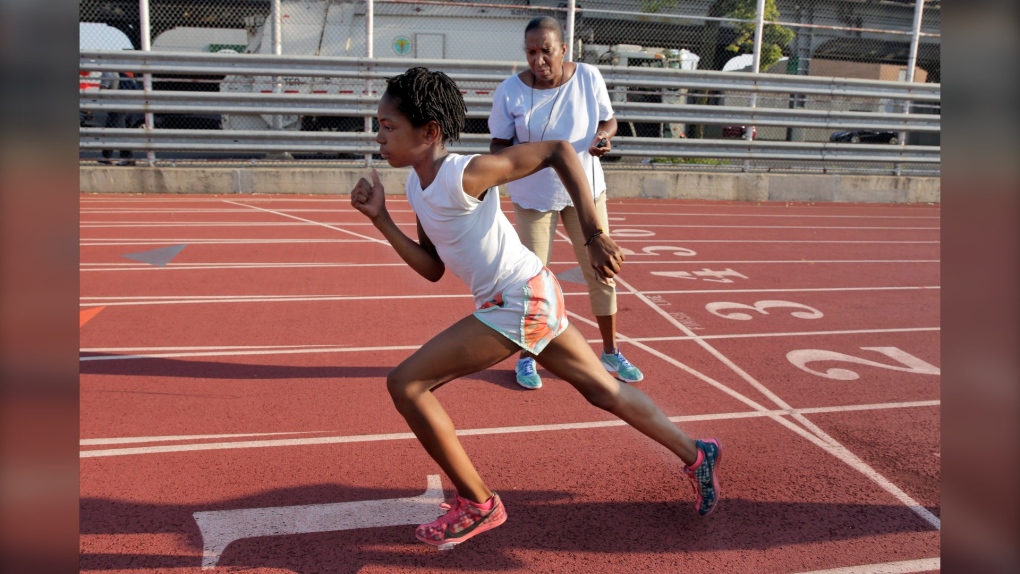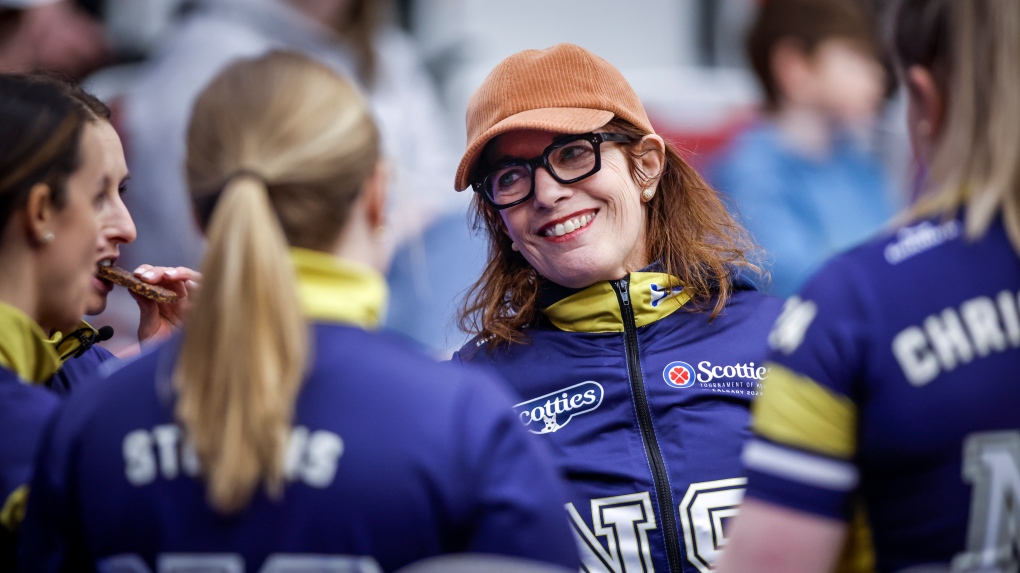'She cannot be what she cannot see': Female coaches key to supporting girls in sports
 Canadian women's hockey coach Melody Davidson jokes with players at the conclusion of the team's practice at the Britannia Centre on Wednesday Feb.24, 2010. (Source: THE CANADIAN PRESS/Scott Gardner)
Canadian women's hockey coach Melody Davidson jokes with players at the conclusion of the team's practice at the Britannia Centre on Wednesday Feb.24, 2010. (Source: THE CANADIAN PRESS/Scott Gardner)
Melissa Parker has been a life-long athlete, participating in ringette, hockey, soccer and figure skating while growing up in the Halifax area.
Despite being on numerous teams, Parker only had a handful of female coaches.
“Most of them were male. I think it’s still the same thing now, a lot of coaches in female sports are male. There are more women now, but still, the majority are male,” she says.
Parker believes it is helpful for female athletes to see themselves in their coach, which is one of the reasons she now leads a girls hockey team.
“One of the girls I coach in hockey, she said to me last year, ‘I think when I get older, I would like to coach as well,’ and I don’t know if she would say that to a male coach,” says Parker.
“It shows them when I’m older, even if I’m not playing anymore, I can still be involved. So, it gives them that role model.”
 Melissa Parker has been a life-long athlete, participating in ringette, hockey, soccer and figure skating while growing up in the Halifax area. (Courtesy: Melissa Parker)
Melissa Parker has been a life-long athlete, participating in ringette, hockey, soccer and figure skating while growing up in the Halifax area. (Courtesy: Melissa Parker)
Girls in sport
According to the Canadian Women & Sport’s 2022 Rally Report, signing girls up to participate in sports is not enough; coaches and decisionmakers “play a critical role in enabling girls’ full participation in sport.”
Allison Sandmeyer-Graves, the CEO of Canadian Women & Sport, says sport has many benefits, but there is still a lot of work to do within the system to ensure everyone can access them.
“What we are really talking about is the history of sport in Canada, and really around the world, that has really been male-dominated. It was really built by men for the benefit of men and boys in many respects,” she says.
“We have so much history in this country where girls have been explicitly denied access to different sports for whatever reasons, told that they are not allowed to play or to lead, and of course that has been changing, absolutely, but a lot of those dynamics are still really deeply embedded in the culture of sports and also in the way that sport is structured and run in the country.”
 Coach Karel Lancaster times Rainn Sheppard, 10, during training at Boys and Girls High School, in the Brooklyn borough of New York on July 12, 2016. (AP Photo/Richard Drew)
Coach Karel Lancaster times Rainn Sheppard, 10, during training at Boys and Girls High School, in the Brooklyn borough of New York on July 12, 2016. (AP Photo/Richard Drew)
Key steps
The Rally Report found there are some key steps to improving sport for girls, including:
- Training coaches and activity leaders on how to build social connections to keep girls and gender-diverse participants in sport so they can reap the mental health benefits of participation.
- Learning how to centre the needs of girls, women, and gender-diverse participants by creating channels for them to provide feedback and have a voice in decision-making.
- Learning how gender equity and inclusion are essential elements for better, safer sport.
- Investing in programs and initiatives that promote girls’ participation in quality, safe sport and physical activity, such as Same Game Challenge or the Gender Equity LENS e-Learning Module.
Female coaches
Carla Alderson is the manager of operations at the Canada Games Centre in Halifax and a hockey coach. She believes the best way to keep girls in sports is to have more female coaches.
“Across sports, there is a lot of those sayings and cliches and metaphors and stuff, but one that I subscribe to a lot is that, ‘She cannot be what she cannot see.’ If she does not see a female or strong, personable, kind female in a position over her right now, how does she know she can be that?” she says.
Sandmeyer-Graves agrees, adding there has been a lot of improvement over the years when it comes to the number of female coaches, but it tends to be a hard thing to move the needle on.
“Which means that many women have only, or would only, experience men coaching. What that really does is, it sort of creates this culture where the authorities on the sport, the people who hold the knowledge and the expertise, or who are perceived to, are all men,” says Sandmeyer-Graves.
 Team Nova Scotia coach Colleen Jones talks to her team at the break as they play Team British Columbia-Grandy at the Scotties Tournament of Hearts in Calgary, Monday, Feb. 19, 2024. (Source: THE CANADIAN PRESS/Jeff McIntosh)
Team Nova Scotia coach Colleen Jones talks to her team at the break as they play Team British Columbia-Grandy at the Scotties Tournament of Hearts in Calgary, Monday, Feb. 19, 2024. (Source: THE CANADIAN PRESS/Jeff McIntosh)
Benefit to boys
Women leading in sport doesn’t just benefit girls; Alderson says it also helps boys.
“Boys that have women as coaches or leaders are more likely to see women in a positive light. So, that is to say, they are less likely to objectify them and more likely to see them as leaders and respect them as leaders and so on,” she says.
“As we know, that can have really positive, big social implications as well. So, sport is this really interesting space of individual empowerment, but also collective empowerment if you will and, done well, can be a real agent of broad social change.”
Facilitating change
To help facilitate an increase in female coaches, Alderson and two other women created a junior coach leadership program within the Metro West Sports Female Hockey Association in Halifax.
“We built this program to develop young girls and women aged U13 in hockey and up and every year we have usually approximately 80 young women and girls who come out to this program. We teach them how to be junior coaches, but truthfully, we are just teaching them to have confidence, to believe in themselves, to have leadership skills and to understand how to communicate and collaborate,” says Alderson.
“Our expectation is that, by exposing them young and exposing them to female coaches and role models and leaders, they will then have the confidence when it comes time for them. That they can step up and say, ‘No, I can do that, that’s definitely something I can do. I did it when I was younger, therefore I’ve got the confidence to go for it now.’”
 Carla Alderson is the manager of operations at the Canada Games Centre in Halifax and a hockey coach. She believes the best way to keep girls in sports is to have more female coaches. (Courtesy: Carla Alderson)
Carla Alderson is the manager of operations at the Canada Games Centre in Halifax and a hockey coach. She believes the best way to keep girls in sports is to have more female coaches. (Courtesy: Carla Alderson)
The need for allies
In addition to programming and education, Alderson stresses the need for allies.
“We need male allies within the coaching world who see the value, and not just say that they see, but act on it and take a young woman under their wing and help them develop some of those coaching skills if they don’t already come with them and make them feel confident and give them opportunities to lead,” she says.
“Because without those allies, 30 years from now we will still be having the same conversation about the percentage of female coaches in sport.”
CTVNews.ca Top Stories

Poilievre writes to GG calling for House recall, confidence vote after Singh declares he's ready to bring Liberals down
Conservative Leader Pierre Poilievre has written to Gov. Gen. Mary Simon, imploring her to 'use your authority to inform the prime minister that he must' recall the House of Commons so a non-confidence vote can be held. This move comes in light of NDP Leader Jagmeet Singh publishing a letter stating his caucus 'will vote to bring this government down' sometime in 2025.
School custodian stages surprise for Kitchener, Ont. students ahead of holiday break
He’s no Elf on the Shelf, but maybe closer to Ward of the Board.
Kelly Clarkson's subtle yet satisfying message to anyone single this Christmas
The singer and daytime-talk show host released a fireside video to accompany her 2021 holiday album, “When Christmas Comes Around” that she dubbed, “When Christmas Comes Around…Again.
Judge sentences Quebecer convicted of triple murder who shows 'no remorse'
A Quebecer convicted in a triple murder on Montreal's South Shore has been sentenced to life in prison without chance of parole for 20 years in the second-degree death of Synthia Bussieres.
At least 2 dead, 60 hurt after car drives into German Christmas market in suspected attack
A car plowed into a busy outdoor Christmas market in the eastern German city of Magdeburg on Friday, killing at least two people and injuring at least 60 others in what authorities suspect was an attack.
16-year-old German exchange student dies after North Vancouver crash
A 16-year-old high school student from Germany who was hit by a Jeep in North Vancouver, B.C., last weekend has died in hospital, authorities confirmed.
Poilievre to Trump: 'Canada will never be the 51st state'
Conservative leader Pierre Poilievre is responding to U.S. president-elect Donald Trump’s ongoing suggestions that Canada become the 51st state, saying it will 'never happen.'
Canadiens executive says he has 'no concern' about members of the front office travelling to Russia
Montreal executive vice president of hockey operations Jeff Gorton said he has 'no concern' about members of the Canadiens' front office travelling to Russia with the country’s war in Ukraine ongoing.
Speeding drivers get holiday surprise from 'Officer Grinch'
Drivers in the Florida Keys who exceed the speed limit in school zones may run into a well-known gloomy green creature and get a surprising 'gift.'


































